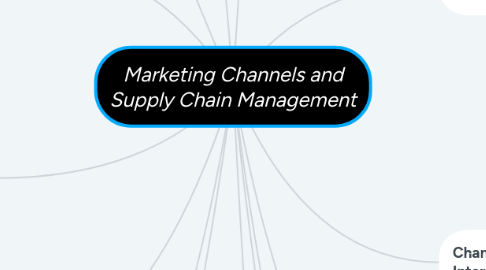
1. System of marketing institutions that enhances the physical flow of goods and services, along with ownership title, from producer to consumer or business user
2. Types of Marketing Channels
2.1. Marketing intermediary
2.2. Resellers
2.2.1. Wholesaler
2.2.2. Retailers
2.3. Brokers
2.3.1. Agents
2.4. Facilitators
2.4.1. Transportation companies
2.5. Service firms market
2.5.1. Haircuts, manicures, and dental cleanings all operate through short channels
3. Direct Selling
3.1. Direct channel
3.1.1. Carries goods directly from a producer to the business purchaser or ultimate user
3.2. Direct selling
3.2.1. Strategy designed to establish direct sales contact between producer and final user
4. Factors influencing Marketing Channel Strategies
4.1. Market factor
4.2. product factor
4.3. organizational factor
4.4. competitive factor
5. Reverse Channels
5.1. Channels designed to return goods to their producers
5.2. Growing importance because of:
5.2.1. Rising prices for raw materials
5.2.2. Increasing availability of recycling facilities
5.2.3. Passage of additional antipollution conservation laws
5.3. Used for recalls and repairs
6. Determining Distribution Intensity
6.1. Intensive distribution
6.2. Selective distribution
6.3. Exclusive Distribution
7. meaning:
8. Control of the activities of purchasing, processing, and delivery through which raw materials are transformed into products and made available to final consumers
9. The Role of Marketing Channels in Marketing Strategy
9.1. Four functions of marketing channels
9.1.1. 1. Facilitating the exchange process by reducing the number of marketplace contacts necessary to make a sale
9.1.2. 2. Adjusting for discrepancies in the market’s assortment of goods and services via sorting
9.1.3. 3. Standardizing exchange transactions by setting expectations for products
9.1.4. 4. Facilitating searches by both buyers and sellers
10. Channels Using Marketing Intermediaries
10.1. Producer > wholesaler > retailer > consumer
10.2. Producer > wholesaler > business user
10.3. Producer > agent > wholesaler > retailer > consumer
10.4. Producer > agent > wholesaler > business user
10.5. Producer > agent > business user
11. Dual Distribution
11.1. Movement of products through more than one channel to reach the firm’s target market
11.2. Example: Nordstrom sells through stores, catalogs, and the Internet
12. Determining Distribution Intensity
13. Transportation
13.1. classes of carriers
13.1.1. Private carriers
13.1.2. Common carriers
13.1.3. Contract carriers

